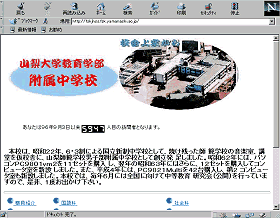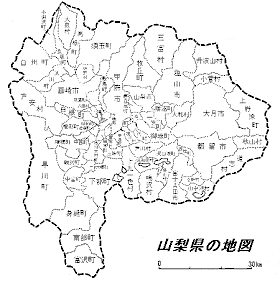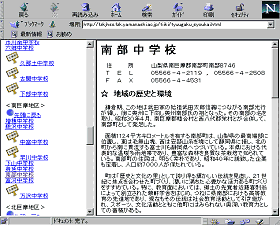Conference to introduce results from the 100-School Networking Project (Phase
II)
Junior high school meeting
Creating a Home Page to Develop a Network for Our Area
Kimihiko Inoue and Tetsuo Akiyama, Junior High School Attached
to the Faculty
of Education of Yamanashi University
1. Introduction
 Since we began
using computers in FY 1983, we've explored ways to incorporate computers for
group use in school lessons. We installed 21 computers in our computer room
in FY1988, and we've used them in lessons, mainly using software we created
ourselves.
Since we began
using computers in FY 1983, we've explored ways to incorporate computers for
group use in school lessons. We installed 21 computers in our computer room
in FY1988, and we've used them in lessons, mainly using software we created
ourselves.
In FY 1994, when Yamanashi University went online, we got an access line for
our own school as well. We participated in the 100-School Networking Project,
set up a server, and established a subnet. Our present status for computer
use is discussed in the "Report for FY 1997" on our home page. The
current home page has links to results of our activities in FY 1995 and 1996.
2. Activities in FY 1997
 This year,
Yamanashi Prefectural Education Center launched an area collaboration project.
We decided to create a home page as part of this project to introduce junior
high schools in Yamanashi to each other, by supplying on our home page information
such as the characteristics of each school, their location and size, and the
characteristics of the surrounding areas.
This year,
Yamanashi Prefectural Education Center launched an area collaboration project.
We decided to create a home page as part of this project to introduce junior
high schools in Yamanashi to each other, by supplying on our home page information
such as the characteristics of each school, their location and size, and the
characteristics of the surrounding areas.
Yamanashi prefecture has a relatively small number of junior high schools:
99 public schools, 3 private schools, and one national school, for a total
of 103 schools. Despite the small size of the prefecture, each region has
its own distinct characteristics. For example, the south part borders Shizuoka
and has a warm climate with lots of rain throughout the year, while the north
part borders Nagano and is very cold in winter. The Kofu Basin, where our
school is located, has some of the hottest summer weather, and yet is very
cold in winter.
We asked every junior high school in the prefecture to cooperate with us in
creating a home page that would describe the characteristics of each area
and the unique activities of each school to people from all over Japan.
Last October, we sent a letter asking for various kinds of information. About
half of them were answered and returned with the information requested. We
also requested links for home pages for those schools already having one.
We entered into our home page the data for schools that sent us information,
and sent a second letter to schools that didn't respond the first time. We're
currently entering data for schools which responded the second time.
3. Educational effects
 Right now,
the home page doesn't have information for every school, and we are still
entering information. To date, the educational payoffs of this project remain
negligible, but we foresee the following benefits:
Right now,
the home page doesn't have information for every school, and we are still
entering information. To date, the educational payoffs of this project remain
negligible, but we foresee the following benefits:
(1) Students will be able to acquire material on areas that their schools
don't currently offer, including a particular region's history, weather, and
cultural assets.
(2) Students can come to understand the unique characteristics of their own
school by comparing it to others, including differences in school or its student
council events, and size.
(3) Students will be able to communicate with students from other schools
to exchange information on similar school events.
We need to review and improve the information offered on our home page to
achieve these effects.
4. Benefits and problems
- We began our project this year by requesting the cooperation of other junior
high schools in the prefecture. We're just beginning, and haven't yet accomplished
much. Still, we believe that our home page will be useful in bringing about
the educational effects mentioned above once students have better access to
the Internet.
We've observed some problems this year, which largely fall into two categories:
problems concerning home page contents, and problems concerning the time and
labor needed to create a home page.
- (1) Problems concerning home page contents
Since we need detailed information to accurately portray the characteristics
of each area and school, we have to determine what information is valuable.
In doing this, we need to be careful about copyright infringements and the
right to use photographs. Some schools sent us material and brochures published
by their town offices. Before using these on our home page, we contacted the
offices and asked for permission to use the material. Some of these requests
were denied, for anxieties about how such information might be used. The possibility
of such denied permission is a reality we have to live with.
- (2) Problems concerning the time and labor needed to create a home page
The important thing for us and the teachers whom we ask to cooperate with
us is developing a close working relationship with students, and trying to
improve our understanding of them. Among the various skills we need to teach
them as we approach the 21st century, information skills are probably among
the most critical. But teaching these skills on a regular basis is very difficult
when no set time has been allotted to do so.
I think information skills will become more valuable when every school has
access to the Internet and can run and update its own home page. By then,
I hope, the issue of necessary class time for information education may be
solved.
 Conference to introduce results from the 100-School Networking Project (Phase II)
Conference to introduce results from the 100-School Networking Project (Phase II)
 Since we began
using computers in FY 1983, we've explored ways to incorporate computers for
group use in school lessons. We installed 21 computers in our computer room
in FY1988, and we've used them in lessons, mainly using software we created
ourselves.
Since we began
using computers in FY 1983, we've explored ways to incorporate computers for
group use in school lessons. We installed 21 computers in our computer room
in FY1988, and we've used them in lessons, mainly using software we created
ourselves. This year,
Yamanashi Prefectural Education Center launched an area collaboration project.
We decided to create a home page as part of this project to introduce junior
high schools in Yamanashi to each other, by supplying on our home page information
such as the characteristics of each school, their location and size, and the
characteristics of the surrounding areas.
This year,
Yamanashi Prefectural Education Center launched an area collaboration project.
We decided to create a home page as part of this project to introduce junior
high schools in Yamanashi to each other, by supplying on our home page information
such as the characteristics of each school, their location and size, and the
characteristics of the surrounding areas. Right now,
the home page doesn't have information for every school, and we are still
entering information. To date, the educational payoffs of this project remain
negligible, but we foresee the following benefits:
Right now,
the home page doesn't have information for every school, and we are still
entering information. To date, the educational payoffs of this project remain
negligible, but we foresee the following benefits:  Conference to introduce results from the 100-School Networking Project (Phase II)
Conference to introduce results from the 100-School Networking Project (Phase II)